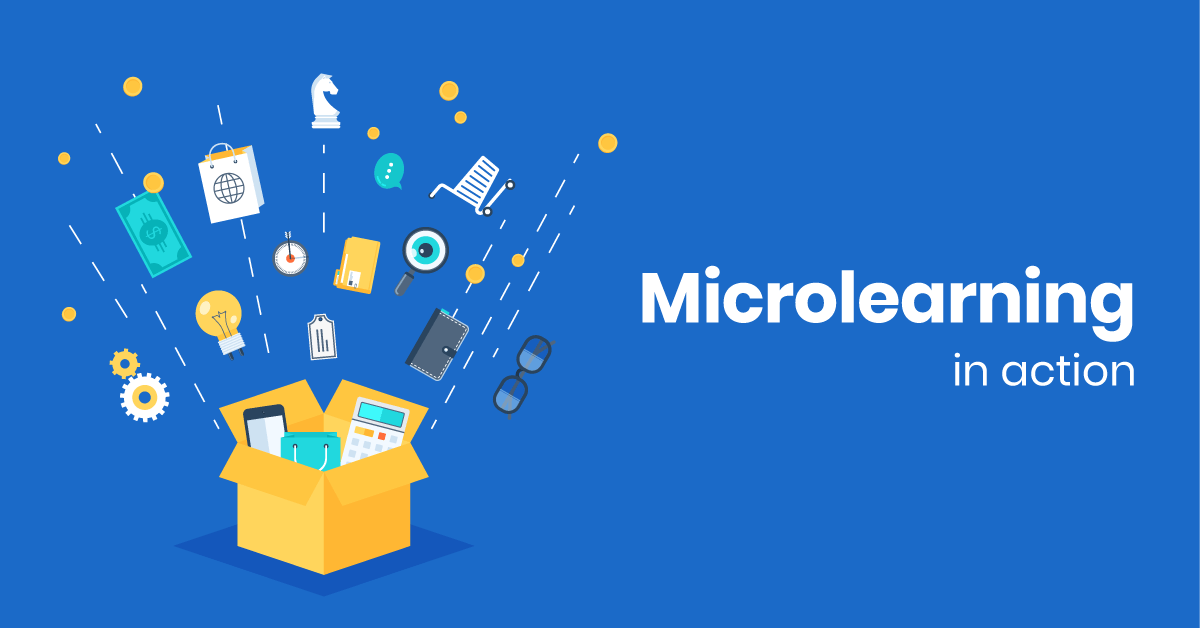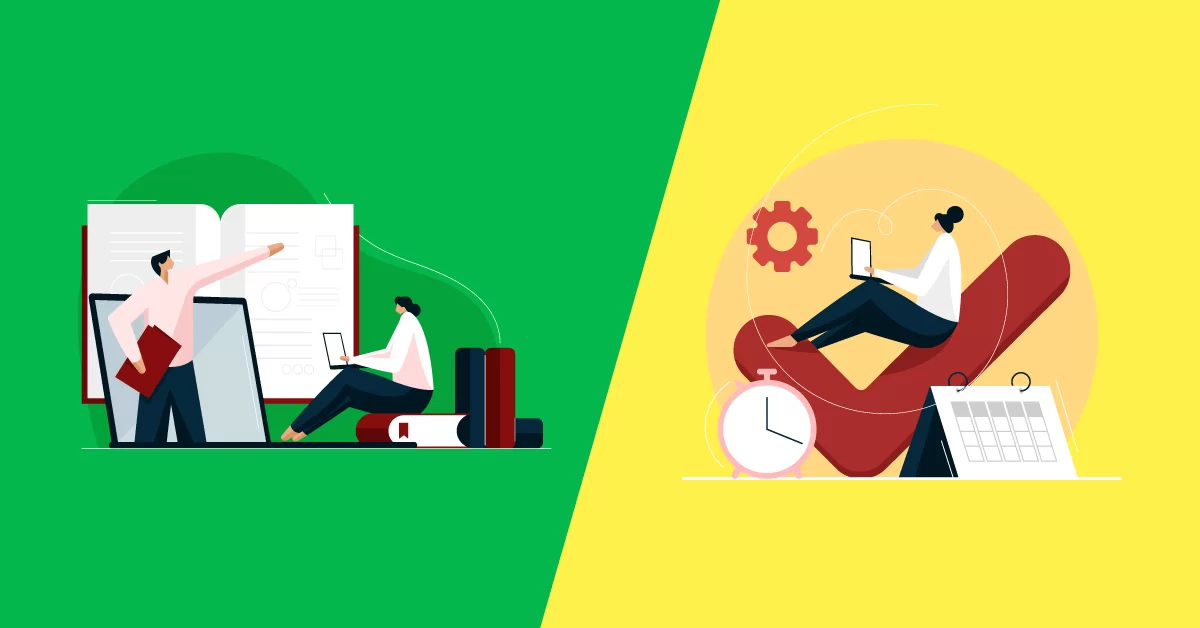There’s hardly a chance anyone enjoys these. Especially when there’s a simpler way to learn.
Microlearning courses have stood the test of time, and met successfully their educational purpose while satisfying the need for fast results. Employers can train their teams even when training needs arise last minute, and employees learn in a more flexible and less time-consuming way.
But how do you go about incorporating microlearning in your L&D initiatives?
In this post, you’ll find out more about microlearning benefits and use cases along with specific microlearning examples. First, let’s answer one key question:
Is microlearning your best option?
Microlearning could be a great addition to nearly any training course. Let’s explore the top microlearning benefits before discussing when bite-sized learning is your best option for delivering employee training.
Immerse learners
The 8-second attention span is debatable. However, nobody can deny that there are lots of distractions when we’re online. An incoming email or notification from our favorite app is enough to make us “switch tab” and forget about training altogether.
Maintaining learner attention is a notorious online training challenge. It takes an extremely skillful instructor to keep participants focused, or genuine interest on behalf of the learner (which isn’t always there).
Bite-sized training beats distractions thanks to its short duration and highly condensed information. Microlearning courses stick to the point, thereby immersing learners and maintaining their attention.
Help employees form a habit of learning
Learning is a habit, too. And unless your employees are already lifelong learners, you’ll need to find a way to help them create and maintain a learning routine.
An effective trick to form a new habit is to start small. Microlearning requires only 10-15 minutes of your employees’ time, and it’s perfect for mobile consumption. Therefore, employees can learn something new in small doses every day, until eventually learning becomes a habit they practice effortlessly.
Boost knowledge retention
Another microlearning benefit is better knowledge retention. Short courses don’t overwhelm your learners’ already busy brains. It’s also easier for them to come into contact with the subject matter on a daily basis.
Plus, with microlearning, you can re-create material and turn it into different formats. For example, you can take a few important concepts from a course and break them down into short videos that explain those terms. This is a perfect—and fast—technique for refreshing people’s memory.
When to use microlearning
It’s not an exaggeration to say you can include microlearning resources in any type of training to wrap up key points. You can create your own or buy ready-made microlearning courses from your LMS vendor for various topics.
Let’s see when you can deliver a training program using microlearning.
Soft skills training
Microlearning is the clear winner for soft skills training or any other theoretical training where people need to get familiar with concepts.
Conflict resolution, sales skills, project management, diversity and inclusion, are just a few examples where you can use microlearning courses to enhance employee skills.
Just-in-time training
The most distinctive microlearning example. Because microlearning imparts knowledge fast and effectively, it’s your go-to choice when you need to see results fast.
Microlearning courses are also an excellent resource that employees can use as a last-minute knowledge refresher or when they are “on the spot” and looking for a quick answer.
Onboarding
Microlearning is perfect for new hires who need info on basic job tasks and company policies. Especially if you’re onboarding remote employees.
Instead of bombarding them with employee handbooks and countless meetings, create microlearning resources they can go through at their own pace and time. They’ll thank you for it.
Basic technical skills
If you’re introducing a new workplace tool, some employees might need more than a one-off demonstration. Most tools, like communication platforms or project management software, come with some sort of training from the vendor.
But if they don’t, ask your IT department to showcase key functionalities in brief videos or in bullet points you can turn into PDF infographics.
When it’s best to avoid microlearning
Now let’s see some cases where microlearning shouldn’t be your primary delivery method.
Manual tasks
Microlearning can’t substitute hands-on practice. When manual tasks that can compromise an employee’s safety are involved, employees need extensive training and continuous practice in the workplace or a simulated environment.
You can always rely on microlearning for a quick overview of safety guidelines, though.
On-the-job training
Again, this is another case where you can use microlearning courses as a point-of-need resource but not as your primary training method. Unless it’s a very simple task, it’s best to use in-person training or shadowing to show employees how to perform their job tasks.
This way, you’ll be able to answer their questions on the spot and practice the task with them.

5 ways to apply microlearning in the workplace
Now let’s explore some microlearning examples that will help better understand how to incorporate microlearning into employee training.
1. Create microlearning videos
Use brief videos to explain in a vivid and direct manner what text can’t. Do you want to discuss your company vision during onboarding? Do you want to demonstrate simple job tasks? Then, a short video fits the bill!
Make your videos interactive for better engagement and learning. For example, you can ask a multiple-choice question before moving on to the next lesson, where you will reveal the correct answer. You could also use animated characters to make your videos more fun.
2. Use flashcards
Flashcards are another great way to present new information in a clear, visual way that evokes employees’ curiosity. Think of flashcards as mini-quizzes where learners get the answer instantly.
They’re quick shots of targeted information, which makes them the perfect tool for occasionally testing your learners.
3. Gamify the learning experience
Add a drag-and-drop activity or a branching scenario and—voila! Training just got a lot more fun. Increase engagement by adding a reward system, like badges or a leaderboard.
Actual games combined with gamification elements will give an extra motive to learners.
4. Deliver training on the go
Microlearning and mobile training go hand in hand. Since you’re already following a flexible training approach, why not maximize intuitiveness and ease of access?
Choose an LMS that is 100% mobile-friendly, so your employees can not only learn on the go but also gain access to valuable resources at the point of need.
5. Repurpose existing training content
Think out of the box for a moment, and let’s not stick to traditional learning content. Have you recently hosted an amazing webinar? Have your experienced employees established work processes they could put down to “paper”? Do you have a subscription to an online magazine with industry-related news?
All these bits of information are microlearning examples that, when put together, can complement or create a microlearning course.
How to measure and maximize the effectiveness of your microlearning courses
Microlearning works like any other type of training, so measuring its effectiveness is not really that different.
First off, you can check whether people have learned what they were supposed to learn with tests and quizzes at the end of their training. For example, if you’ve created a course on conflict resolution, create a “real-life” situation your employees will have to resolve. Give them a workplace conflict scenario and see how they will work around finding a peaceful solution.
You can also get feedback from employees themselves. Ask them if they feel confident they have gained solid knowledge they can actually apply, or whether they need more in-depth training.
Finally, you can tell whether your microlearning courses are successful by seeing—or not—the actual results on the job and in the workplace. This might take a while, but training should always bring some sort of change in the workplace. Whether it’ll be faster project delivery, fewer tickets for your customer support, or an increase in your client base—it all depends on your specific goals.
Prevention is better than cure though, so here are some ways to get the most out of your microlearning courses:
- Combine different media. Microlearning plays well with videos, podcasts, quizzes, flashcards, infographics, and drag-and-drop activities. Mix things up, so microlearning is an entertaining as well as an effective learning experience.
- Quiz, quiz, and quiz some more. Microlearning can trick employees into taking quizzes without feeling the pressure of “exams.” Add some pop-up questions here and there to boost memory recall. Flashcards are the best option for this.
- Follow up with on-the-job practice and related activities. No number of quizzes is enough to help employees retain knowledge unless they fully internalize it first. From sales techniques to diversity and inclusion, create opportunities for employees to practice what they learned. Offer additional resources so they don’t lose touch with the subject, like an informative article or a brief webinar.
Microlearning doesn’t mean fast training
Microlearning courses give you and learners flexibility. You don’t have to update your entire training program if one piece of information needs to be changed. And learners don’t have to sit down for hours to complete a course—they can take their training bit by bit.
But just because training is short-sized, it doesn’t mean it’s rushed or lacking in depth. If anything, the flexibility that microlearning courses offer makes training easier. And when employees don’t see training as an extra burden, or as another thing they need to “get it over with”, they’re more likely to engage. And that’s how you invest in continuous learning.



